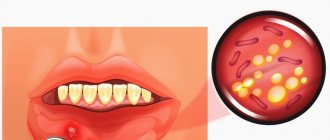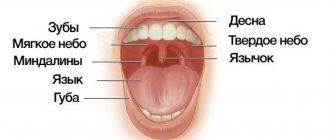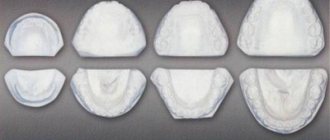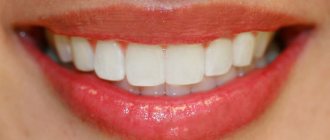There are a huge number of different glands in the human body, but most of them are microscopic and only a few are relatively large in size. Microscopic glands in the walls of the tubular organs of the digestive, respiratory, urinary and reproductive systems produce mucus, which moisturizes and protects the walls of the cavity, which is why the inner lining of the tubular organs is called mucosa. Single-celled glands (goblet cells), which are part of the epithelium of the gastrointestinal tract, and other small digestive glands produce enzymes necessary for the digestion of food. Numerous small glands in the skin are sweat and sebaceous glands. Harmful, unnecessary compounds are removed from the body through sweat and sebum.
In cases where the body requires a large amount of a special substance (secret) to carry out functions, its production is carried out by complex large glands, isolated from other organs. Such glands are, for example, the female mammary gland, pancreas, lacrimal gland, major salivary glands, etc.
Types of glands
Most glands have excretory ducts through which secretions reach the surface of the body or mucous membranes. Such glands are called exocrine (exo - “outside”, crino - “excreting”), or exocrine glands. These include all skin glands, lacrimal, salivary glands, liver, etc. Glands that do not have excretory ducts and secrete secretions (hormones) directly into the blood are called endocrine (endo - “inside”), or endocrine glands. Hormones are highly active substances that, in very small quantities, can influence various body functions. The endocrine glands include the pituitary gland, pineal gland, adrenal glands, thyroid, parathyroid and thymus glands. The gonads (ovary and testicle) and the pancreas belong to the glands of mixed secretion, because have both exocrine and endocrine functions.
Inside the gland, parenchyma cells are grouped into areas of a certain shape, depending on which the glands are distinguished as alveolar, tubular and alveolar-tubular. They can be simple or branched. For example, alveolar glands may consist of a single vesicle, or alveolus (simple alveolar gland), several alveoli (branched alveolar gland), or many alveoli forming clusters (complex alveolar gland). In tubular glands the main structural component is a tube, in alveolar-tubular glands it is both a vesicle and a tube. As a rule, large glands have a complex alveolar-tubular structure, which allows them to produce a large volume of secretion.
Diagnostics
Diagnostic studies include external and instrumental examination. It is necessary to differentiate diseases of the salivary glands from diseases that have similar symptoms: lymphadenitis, oral tumors, perimandibular phlegmon, infectious mononucleosis. To do this, an ultrasound of the salivary glands is performed, and sialography is an x-ray of the salivary glands. If a malignant process is suspected, a biopsy followed by histological examination is necessary.
The structure of the salivary glands
The salivary glands, the ducts of which open into the oral cavity, belong to the digestive glands and produce substances necessary for the digestion of food. Small salivary glands are scattered throughout the mucous membrane of the tongue and oral cavity: they are present on the lips, cheeks, palate, and gums. These glands constantly produce small amounts of saliva, which moisturizes the mucous membrane of the mouth. There are three pairs of large salivary glands: parotid, submandibular and sublingual (Fig. 1). They are located outside the oral cavity, but their ducts open into it.
The parotid gland, the largest, weighs about 30 g and is located on the side of the face in front and below the auricle. The excretory duct of the parotid gland runs under the skin across the cheek, then pierces the buccal muscle and opens on the inner surface of the cheek at the level of the second upper molar. The submandibular gland weighs 15 g and is located under the skin in the bottom of the mouth (in the so-called submandibular triangle). Its excretory duct opens into the oral cavity on the sublingual papilla on the side of the frenulum of the tongue. The sublingual gland (weight - about 5 g) is located in a fold of the mucous membrane at the bottom of the oral cavity. The main duct of the sublingual gland opens together with the duct of the submandibular gland at the sublingual papilla, and several small ducts have openings along the sublingual fold of the mucosa.
The large salivary glands have a lobular structure. Each lobule is alveolar-tubular. Connecting with each other, the tubes form a system of efferent ducts, which merge into the common excretory duct. In newborn children, the salivary glands are poorly developed; their rapid growth occurs in the period from 4 months to 2 years. An increase in size of the large salivary glands is observed up to 25–30 years of age, and after 55–60 years of age they decrease.
During the day, the small and large salivary glands secrete from 0.5 to 2 liters of saliva, consisting mainly of water (up to 99.5%), salts, amylase enzymes and some others, mucus, the bactericidal substance lysozyme and immunoglobulins. The main function of saliva is to wet food and begin its digestion. Under the influence of salivary enzymes, the breakdown of carbohydrates begins in the oral cavity. The mucus contained in saliva makes swallowing easier. Lysozyme disinfects the oral cavity. Saliva ensures the dissolution of nutrients and the entry of their molecules into the taste buds of the tongue for analysis. The composition of saliva varies depending on the glands that produce it. The parotid gland and minor glands of the tongue secrete liquid saliva rich in enzymes. Glands located on the base of the tongue and the roof of the mouth produce a mucous secretion rich in mucin. The submandibular and sublingual glands, minor glands of the lips and cheeks produce mixed saliva. The enzyme composition and properties of saliva change with a person’s age and depend on the diet and type of food.
Salivation is a reflex act and increases at the sight of food, in response to its smell, and even when thinking about food. The quality of food affects the quantity and properties of saliva: the harder and drier the food, the more saliva is secreted. Study of the reflex function of salivation in dogs by the great Russian scientist I.P. Pavlov formed the basis of the scientific direction he created - the physiology of higher nervous activity. I.P. Pavlov developed a conditioned reflex in dogs by first combining the delivery of food with an auditory or visual signal, and then observing the production of saliva in response to the signal without presentation of food. The conditioned reflex is based on the formation of nerve connections between the centers of the brain.
The center of salivation is located in the medulla oblongata. It is to this center that a signal comes from receptors in the oral cavity when food hits the tongue. Here, even before food enters the mouth, signals from the olfactory, visual and even auditory centers arrive via nerve connections, carrying information about the smell, appearance and simply the name of food. Therefore, salivation begins in advance, naturally, if previous experience has already developed a corresponding conditioned reflex in a person. From the salivary center, the command to produce saliva is transmitted to the glands through the autonomic nerves, while the parasympathetic nerves stimulate the release of large amounts of saliva, and the sympathetic nerves reduce salivation and thicken saliva. Inhibition of salivation, leading to dry mouth, can be caused by pain, negative emotions, and mental stress. On the contrary, excessive salivation causes toxic substances and suffocation.
The type of food and the beginning of its processing in the oral cavity reflexively stimulate the secretion of gastric juice. Therefore, it is so important to properly organize your diet, observing all the “rituals” that precede meals, and paying attention to the quality and attractiveness of the products consumed.
Preparation for the Unified State Exam. Topic "Digestion"
Digestion
1.What are the functions of the human digestive system?
1 mechanical processing of food occurs in the digestive organs; 2 chemical processing of food is carried out with the help of enzymes; 3 movement of food and throwing away undigested food debris; 4 absorption of nutrients, mineral salts and water into the blood and lymph
2.What is the difference between enzymes and inorganic catalysts?
1 one enzyme catalyzes only one type of reaction; 2 enzyme activity is limited to a fairly narrow temperature range; 3 enzymes are active at certain pH values
3. How do enzymes differ from inorganic catalysts?
1 one enzyme catalyzes only one type of chemical reaction 2 enzymes are active only at certain physiological values of solution acidity and temperature 3 rate of enzymatic reactions in decis. thousand times higher than the speed of reactions occurring with the participation of an inorganic catalyst
4. What are the similarities between enzymes and inorganic catalysts?
1 they reduce the activation energy (this energy is necessary in order to force the substrates to react) 2 they do not change the direction of the reaction, but only change the rate of its occurrence 3 in a catalyzed reaction, less energy is always spent than in a non-catalyzed one
5.What is the nature of most enzymes and why do they lose activity as radiation levels increase?
1) most enzymes are proteins; 2) under the influence of radiation, denaturation occurs, the structure of the protein-enzyme changes.
6.What is the specificity of enzymes? 1.
The active center of the enzyme, in its spatial configuration, mirrors the substrate - the substance with which it enters into a contract.2. The enzyme does not come into contact with any other substance. 3. This is why a particular enzyme speeds up a particular reaction.
7. Salivary enzymes are active in the oral cavity, but lose their activity in the stomach. How can this be explained?
1) salivary enzymes are active in a neutral and slightly alkaline environment, which is characteristic of the oral cavity 2) in the stomach, the environment is acidic, therefore salivary enzymes are inactive
8. Why does the enzyme pepsin, which breaks down proteins in the acidic environment of the stomach, lose its activity when it enters the duodenum??
1. Pepsin is active in an acidic environment, 2. in an alkaline environment of the duodenum, it loses its activity
9.Why should food be chewed thoroughly?
1. Well-chewed food is more easily saturated with saliva in the mouth and digestive juices in the stomach and intestines 2. Therefore, chewed food is more easily broken down by digestive enzymes.
10.Why should you try to chew semolina porridge?
1) Porridge contains a lot of carbohydrates. 2) Insufficient time for food to remain in the mouth means that not all carbohydrates will be broken down by enzymes and will not be absorbed by the body
11. What role do the salivary glands play in digestion in mammals? List at least three functions.
1) the secretion of the salivary glands moistens and disinfects food; 2) saliva participates in the formation of the food bolus; 3) salivary enzymes contribute to the breakdown of starch.
12.What is the role of saliva in digestion? What reflexes provide salivation and under what conditions?
1) saliva contains enzymes that break down starch, as well as substances that form a food bolus for swallowing; 2) unconditioned reflex salivation occurs when the receptors of the oral cavity are irritated; 3) conditioned reflex salivation occurs in response to irritation of the visual, olfactory, and auditory analyzers .
13. Find errors in the text. Indicate the numbers of sentences in which errors were made and explain them. 1. The stomach is the widest part of the digestive tract. 2. It is located above the diaphragm on the left side of the abdomen. 3. The gastric mucosa contains many glands. 4. Some of them secrete sulfuric acid, which activates the work of digestive enzymes. 5. These include pepsin, amylase and maltase.6.Food from the stomach enters the duodenum through the muscular sphincter.
Errors are contained in the sentences: 1) 2 - the stomach is located under the diaphragm; 2) 4 - the glands of the stomach secrete hydrochloric acid; 3) 5 - amylase and maltase are not enzymes of gastric juice. These are salivary enzymes.
14. How is neurohumoral regulation of gastric juice secretion carried out in the human body? Explain your answer.1.
nervous regulation is carried out by direct irritation of the receptors of the oral cavity and stomach (unconditioned reflex) 2. nervous regulation is carried out by irritation of the receptors of the visual, auditory, olfactory analyzers (conditioned reflex) 3. humoral regulation: products of the breakdown of organic substances formed in the stomach are absorbed into the blood and through blood affects the glands of the stomach (gastrin)
15. In a sheep, the length of the intestine is approximately 28 times greater than the length of the body, in a person - 6 times, and in a lion - only 3 times. What explains this difference?
1) Plant foods (fiber) are more difficult to digest in the digestive canal than animal foods. Consequently, the length of the intestine depends on the nature of the food consumed: the more plant food it contains, the longer the intestine. 2) The sheep eats exclusively plant food, and it has the longest intestine; The lion eats meat, and it is easily digested and assimilated. Man eats mixed food
16.What is the relationship between the structure and functions of the human small intestine?
1. the intestinal walls have glandular epithelium, the cells of which produce enzymes that promote digestion 2. intestinal villi greatly increase the area of the mucous epithelium, which ensures efficient absorption of nutrients
17.What is the significance of the large length of the small intestine for the digestion of food?
1) The long length of the small intestine allows the completion of the conversion of organic matter from food into soluble compounds 2) The long length of the small intestine facilitates the absorption of nutrients
18.What features of the inner surface of the small intestine ensure intensive absorption of nutrients in it?
1) Intensive absorption of nutrients is ensured by a large suction surface area, which is many times greater than the surface of the human body. 2) The absorption surface area increases due to the presence on the inside of the small intestine of a large number of villi and microvilli covered with epithelial tissue
19. In which part of the digestive tract do symbiotic microorganisms live, what function do they perform?
1 live in the large intestine 2 bacterial enzymes break down fiber, preventing the process of rotting 3 bacteria synthesize vitamins K and B12
20. A large number of bacteria live in the large intestine and constitute normal microflora, their
role.
1. break down fiber and also destroy unabsorbed protein digestion products2. synthesis of B vitamins, vitamin K.3. suppression of the proliferation of putrefactive and pathogenic bacteria
21.Why can treating a person with antibiotics lead to intestinal dysfunction? Give at least two reasons. 1
. antibiotics kill beneficial bacteria that live in the human intestines 2. the breakdown of fiber, water absorption and other processes are disrupted
22.What negative consequences for human health can the use of pesticides have to combat the Colorado potato beetle? Explain why.
1. poisons accumulate in potato tubers 2. eating such potatoes can cause poisoning and other diseases
23. What functions does the liver perform in the human and animal body?
1. produces bile, which is involved in the breakdown of fats; 2. it disinfects toxic substances that are formed in the body or come from food; 3. in the liver, glucose is converted and stored in the form of glycogen; 4. participates in the regulation of the metabolism of fats, proteins, vitamins, hormones and other biologically active substances;5. participates in the production of thrombin, fibrinogen5) is the site of destruction of red blood cells, blood depot functions
24.Functions of bile
1. emulsifies fats, which is necessary for their breakdown by pancreatic lipase 2. promotes the absorption of fat breakdown products in the small intestine 3. stimulates the secretory activity of the pancreas 4. neutralizes the acidic contents of the stomach entering the duodenum 5. enhances intestinal motility 6. promotes excretion a number of foreign and harmful substances to the body
25. What can cause vomiting?
1. entry of toxic substances into the blood 2. irritation of receptors in the mucous membrane of the digestive canal 3. conditioned reflex 4. diseases (hypertension, hepatitis)
26. In practice, it has been observed that when taking medications by mouth, their effect is weaker than when administered intramuscularly or into a vein. Give an explanation for this phenomenon.
1. when taking medications by mouth, some of them are destroyed in the digestive canal and in the liver 2. from the muscles or veins they are more likely to enter the internal environment
27.Can a person eat only fats, excluding protein foods from the diet?
1) It cannot. 2) The absence of proteins will lead to the fact that the following functions will not be performed in the cells: enzymatic, motor, protective, transport. 3) The synthesis of proteins from fats is impossible, because proteins have a more complex structure (their molecules include nitrogen and sulfur).
28.Why should the human diet include food of animal origin?
1) Plant proteins, unlike animals, do not contain all the amino acids necessary for the formation of proteins specific to the human body 2) Animal fats are closer in composition to human fats than plant fats
29. It is recommended to use “seaweed” - kelp - in the human diet. What is the significance of its use in normalizing body functions?
1) Laminaria is a brown algae that contains iodine. 2) Iodine is necessary for the normal functioning of the thyroid gland. Iodine is part of the hormone thyroxine, which in turn regulates metabolism and the functioning of the nervous system.
30.What measures are used to combat parasitic worms?
1. Compliance with personal hygiene rules2. Purification of drinking water3. Sanitary control in slaughterhouses and food preparation.
31.Where is the center of unconditioned reflex regulation of pancreatic juice located and what is the humoral regulation of this process? What is the role of this juice in digestion?
1) the center is located in the medulla oblongata
2) humoral regulation is due to substances entering the blood during the breakdown of food
3) pancreatic juice contains enzymes that break down proteins, lipids, and carbohydrates of food into their monomers, which can be absorbed by the body’s cells
32. People of many professions stand motionless on their feet throughout the working day, so they often develop an occupational disease - dilatation of the veins of the lower extremities. Explain why this is happening.
1) when standing for a long time, the outflow of blood from the veins is disrupted; 2) there is no contraction of the muscles of the lower extremities, which contribute to the contraction of the walls of the veins and the movement of blood upward
33.Where are the centers of food regulation of gastric juice located in the human body? How is unconditioned reflex and conditioned reflex regulation of digestive processes carried out?
1) the unconditioned reflex center is located in the medulla oblongata. Conditioned reflex - in the GM KBP2) the conditioned reflex center ensures the separation of gastric juice when food enters the oral cavity and stomach 3) Conditioned reflex release of gastric juice occurs at the sight, smell, thought of food
34. Find errors in the given text. Indicate the numbers of the sentences in which they are made, correct them. 1. In the oral cavity, food is crushed and moistened with saliva. 2. Saliva contains enzymes and substances that kill germs. 3. Saliva enzymes break down proteins into amino acids. 4. The esophagus produces enzymes that cause chemical changes in food. 5. The movement of food gruel occurs due to the contraction and relaxation of the muscles of the intestinal walls. 6. Absorption of the bulk of nutrients occurs in the cecum. Errors were made in the sentences:
3 - salivary enzymes do not act on proteins, but break down starch; 4 - enzymes are not produced in the esophagus, so their effect is excluded; 6 - absorption of the bulk of nutrients occurs in the small intestine.
35.What is the role of saliva in digestion? What reflexes provide salivation and under what conditions?1) saliva contains
enzymes that break down starch, as well as substances that form a food bolus for swallowing; 2) unconditioned reflex salivation occurs when the receptors of the oral cavity are irritated; 3) conditioned reflex salivation occurs in response to irritation of the visual, olfactory, and auditory analyzers.
36. Indicate the functions of the large intestine of mammals and humans.1
. Formation of burl masses
2. Suction of most of the water3. Normalization of digestion and absorption due to bacterial flora 4. Carrying out the act of defecation.5. bacteria break down fiber and also destroy unabsorbed protein digestion products, ensure the synthesis of B vitamins, vitamin K, suppress the proliferation of putrefactive and pathogenic bacteria
37. Biological scientists measured the length of the digestive system of a predatory and herbivorous animal of equal size. Which of these animals had a longer digestive tract and why?
A plant cell, in addition to the plasma membrane, also has an outer cellulose membrane that protects it from the influence of environmental factors. This membrane is more difficult (and takes longer) to destroy with the help of digestive enzymes than the plasma membrane of an animal cell. Therefore, animal food is digested faster than plant food.
38)
Functions of bile
1. emulsifies fats (turns them into droplets), which is necessary for their breakdown by pancreatic lipase (i.e. activates lipase)
2. promotes the absorption of fat breakdown products in the small intestine
3. stimulates the secretory activity of the pancreas
4. neutralizes the acidic contents of the stomach entering the duodenum
5. enhances intestinal motility
6. helps eliminate a number of substances that are foreign and harmful to the body
39) Why should food be chewed thoroughly before swallowing?
- Chewing food is a mechanical process that increases the surface area of contact with saliva.
- Salivary enzymes help break down complex carbohydrates into simple ones, and lysozyme disinfects food.
Treatment
Treatment tactics for the salivary glands depend on the causes of the disease.
Treatment of sialadenitis
Treatment of sialadenitis is carried out with antibacterial and antiviral drugs. Medicines are taken orally. In severe forms of inflammation, antibiotic injections can be administered directly into the gland duct. Antiviral agents are also used for local irrigation of the oral cavity. When a purulent process develops, it is necessary to open the abscess, provide drainage and sanitation of the wound.
If the inflammatory process is accompanied by the appearance of stones in the ducts, the doctor performs bougienage (dilation of the duct to facilitate the passage of stones).
Chronic sialadenitis requires physiotherapy: electrophoresis, UHF therapy. Physiotherapeutic procedures help relieve inflammation and accelerate tissue regeneration.
Treatment of salivary gland cysts
Conservative treatment of cysts, as a rule, does not bring results. Surgical treatment is indicated for patients. Depending on the location of the cyst, the surgeon provides intraoral or external oral access to it.
Minor salivary gland cysts are removed using local anesthesia. Cysts of the major salivary glands must be removed along with the gland. This ensures that there is no risk of relapse of the disease.
Treatment of salivary gland tumors
Benign tumors must be surgically removed along with the gland. After surgery, it is necessary to conduct a histological examination to confirm the benign nature of the neoplasm. Surgery to remove a salivary gland tumor requires careful visual monitoring and the professionalism of the doctor, as it carries a risk of damage to the facial nerve.
Treatment of malignant tumors is carried out surgically, and nearby lymph nodes are simultaneously removed. Radiation therapy is also performed. The risk of relapse depends on a combination of several factors: the stage at which the malignant process was detected, the patient’s age, and the presence of concomitant diseases.









